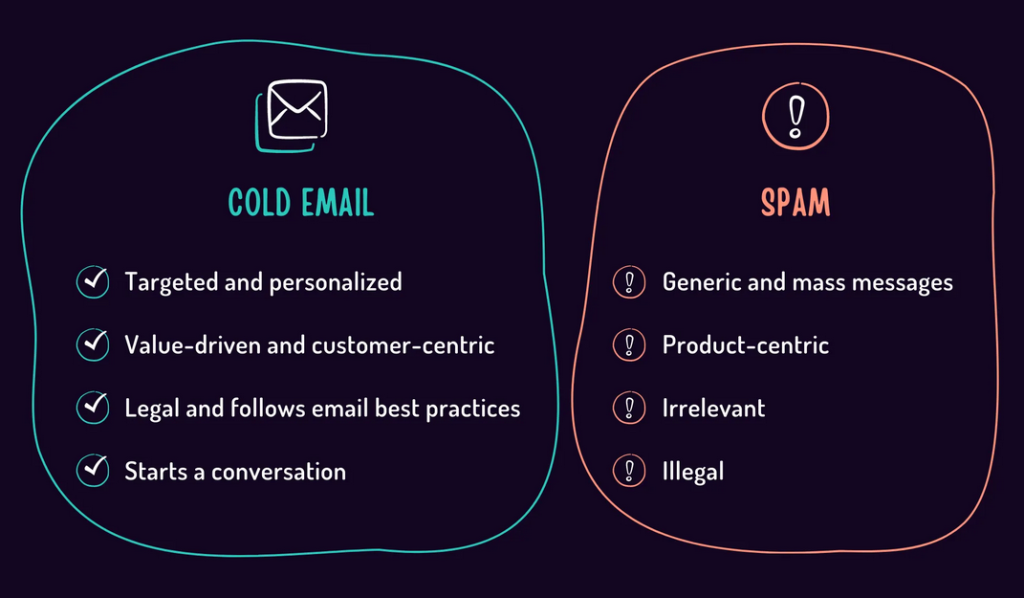- Home
- Email Tips and Tricks
- Cold Email vs. Spam: Where’s ...

You are sending a cold email to a potential client. Well-drafted and, obviously, quite relevant to their needs. It took you twenty minutes to get it right, but now you are confident: this one is a money maker, your offering could not be more on point and more fitting to your lead.
Just as you are about to hit Send, your phone buzzes. You hate those annoying interruptions, always when you are the most productive and finally are getting some important work done. And the worst thing about it: it’s just another spam email. One of two dozen a day, irrelevant and obnoxious.
Sounds familiar? There is a fine line between a well-crafted cold email and a super annoying spam email. Truth be told, in many cases it might not even depend on how good you are or how relevant your email is. Recipient characteristics and circumstances play just as big a role.
So, while some emails are well received and pique the readers’ interests, others are immediately identified (and flagged) as spam. What is the difference between those two? Can you send unsolicited emails? Are cold emails illegal? This article will answer these questions and show where the cold email vs. spam line is drawn and how you can move in the right direction.
Not All Unsolicited Emails Are Spam: The Difference
The word “unsolicited” often has a negative connotation, as it evokes the idea of intrusion. But in the context of email, being unsolicited doesn’t make a message spam. What is an unsolicited email? In its broadest sense, it’s any email sent without the recipient’s prior request or permission. But that definition, while technically accurate, misses the nuance.
If we talk about unsolicited emails in the cold email vs. spam context, a cold email is typically sent for a legitimate business purpose, like an introduction of a service or proposing a collaboration. It is most likely directed to a certain audience, and, most importantly, it respects the boundaries of consent and offers a clear way to decline future communication.
Spam, by contrast, is often sent in mass quantities, without targeting, context, or clarity. Subject lines may mislead. Content may be irrelevant. There’s usually no opt-out either. It’s not that these emails are unsolicited, but they ignore recipients and their needs altogether. They are emails that take rather than offer. Spam doesn’t try to start a conversation or build relationships—it demands attention without offering any value.
Is Cold Emailing Illegal? Compliance Is Not Optional
Cold email is not illegal per se. Yet, hefty fines and spam folders risk making this question surface often enough. So, the more appropriate answer is that legality depends on how you send, to whom, and whether you follow the rules designed to protect recipients from abuse. So, it is more correct to say that cold email isn’t outlawed but regulated.
Across regions, laws vary, but the principles tend to echo each other. In the United States, the CAN-SPAM Act doesn’t prohibit cold outreach, but it does impose clear conditions: you must clearly identify yourself, avoid misleading subject lines, provide a physical business address, and offer a visible, functional way to unsubscribe. So, if you are sure that your cold emails are compliant with these regulations, you are welcome to send unsolicited emails.
In Europe, the GDPR takes a more rigid approach. Consent is more central here, especially when personal data is involved. Sending cold emails under the GDPR is still possible, but it requires a legitimate interest, strong justification, and a high standard of transparency. Canada’s CASL, meanwhile, sits somewhere in between, requiring express consent in many cases and placing a heavy burden on the sender to prove they followed proper procedure.

The Red Flags That Turn Cold Email into Spam
Even well-intentioned cold outreach can be derailed by poor execution. What makes people hit Mark as spam in most cases is not that they get an unsolicited email, but that this email feels careless, vague, or intrusive. Below are five common red flags that shift a message from being legitimate unsolicited into the territory of actual spam.
🛑 No personalization
Being generic in cold emails is probably one of the fastest ways to alienate a recipient. If your message begins with “Hi there,” “Sir or Madam,” or includes irrelevant details that strongly suggest you don’t know your audience, it immediately signals mass outreach. Personalization needs to show that you’ve done your homework and that you were serious about learning your audience’s interests, pain points, or desires. So, if you really want to keep your cold emails out of the spam folder, do your homework before—and do it well.
Personalized email example

🛑 Misleading subject lines
Spam emails have very particular subject lines. They may inflate urgency or fake excitement—for example, “You won!” They may mimic replies or forwards (“Re: Our meeting”) or overpromise results (“Double your sales in three days”). So, while it’s crucial to make your subject line feel intriguing or promising, please make sure that the level of excitement is aligned with your content and that your email delivers the value promised by your subject line.

🛑 No clear opt-out
Today, opt-out is a legal requirement, and it is also a matter of basic respect. If you don’t have one, it means you are sending something illegal and you don’t respect your audience. Even an unsolicited email must include a way for the recipient to say, “No, thank you.” And it doesn’t have to be some huge button overshadowing your whole content. Instead, you can use a sentence like, “Let me know if you’d prefer not to receive these emails” at the end of your message or a formal unsubscribe link. Whatever representation you choose, make sure it’s there. So, if you’re wondering, “Is it illegal to send unsolicited emails without an opt-out option?” in many cases, the answer will be yes.
🛑 Sending to scraped lists
Using scraped lists for sending your messages is something that moves the cold email vs. spam border firmly toward the latter. Buying or scraping email addresses from internet directories or social platforms might feel like a shortcut—but a very doubtful one. It’s ethically questionable, and it’s legally dangerous. It violates the GDPR, may breach platform terms of service, and almost always guarantees low engagement.
🛑 Over-frequency or follow-up abuse
It’s important to know when to stop with any kind of email sequence, but with cold emails it might be even more important. Sending too many messages in a short time frame damages your domain reputation and increases your chances of being marked as spam. So, if your recipient hasn’t responded, first re-evaluate the relevance of your offer and timing accuracy. If you keep on sending unsolicited email repeatedly and with no signs of engagement, you risk crossing the line from persistence to pestering.
How to Keep Cold Email Ethical and Effective
✅ List segmentation and quality > quantity
The temptation to send your offer to as many people as possible is understandable. After all, more outreach should mean more results, right? Not exactly. Because if there’s one thing that separates an honest cold email from spam, it’s targeting. Cold outreach works when it feels intentional. When it actually lands in the right inbox. So, start by segmenting your audience in the right way. This will help you to understand whether those people want to hear from you and if you have something real to say.
✅ Research and relevance
If you have the right recipient’s name, but everything else in your email reads generic, that email won’t be relevant for your audience. If you want your cold email to have a chance, show them that it’s not random. Show them that you’ve read something about them, that you understand their world, their pain points, or even just their context. You don’t need to research each person’s bio, but you do need to show that this email could only have been sent to them.
✅ Clear value exchange (WIIFM: What’s In It For Me)
Recipients don’t want to get emails just because they’re interesting to read or designed nicely (although these things definitely matter). But primarily, each recipient is looking for clear value in your emails. They ask a question—what’s in it for me? And you should ask this question yourself as well to craft an offer that can really help people in solving their pain points. And while design and copy are surely important, if the recipient doesn’t see value, they won’t matter on their own. Ultimately, your whole offer will just fade. So, make the benefit obvious in a specific and clear way and then wrap it in a nice design.
✅ Honest, respectful follow-ups
There’s a thin line between being persistent and being annoying. People are not consistent sometimes. They cannot or don’t want to answer right after they get your email. But it also doesn’t mean you should show up every two days asking if they saw it. Learn to be subtle: a short reminder a week later will be good enough. With follow-ups, pushing too hard is worse than pushing too little—because that’s risking stepping into spam territory. And once this line is crossed, it’s hard to go back.
Deliverability, Brand, and Trust—Why They Matter
👉 Your domain has a reputation—protect it
Every email that gets ignored or flagged as spam affects how inbox providers treat your address. When your sender score drops, even relevant messages can become irrelevant. So, take care of your domain reputation by sending content that matters to your audience.
👉 Your first impression is your brand
Cold emails are often the first time someone hears from you. If they come off as careless, irrelevant, or pushy, that’s what your brand becomes in their mind. And in the cold email vs. spam equation, that impression can stick.
👉 Yes, there are legal lines
Whether it’s the GDPR, CAN-SPAM Act, or CASL, cold outreach comes with legal responsibilities. Clear opt-outs are a must. Sending to scraped email addresses is a no-go. Still asking, “Is cold emailing illegal?” The short version: not if you do it right. But there’s not much room for mistakes either.
An Example of Good Cold Email

To Sum Up
Nobody wants to receive spam. So, making sure your email is not received by potential readers as such is crucial. Remember, a cold outreach email means that this is the first point of contact between you and the other party. How these future conversations will go (if at all) will be shaped by this very first impression. The first email should not only be about you. While you want to show off your amazing product or service, you also need to give the other party a good reason to care.
The key to ethical and effective outreach is knowing where the line is—and why crossing it, even accidentally, has consequences. So, from there on, start building mutual trust and sending unsolicited emails that respect the recipient’s time and autonomy.



